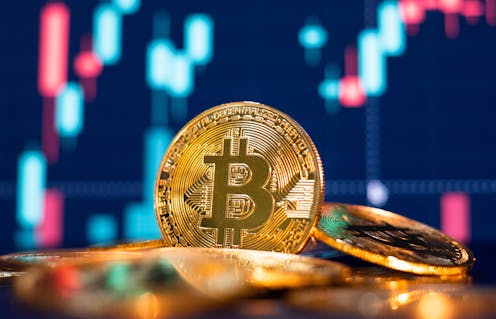Bitcoin is halving again – what does that mean for the cryptocurrency and the market?
- Written by Andrew Urquhart, Professor of Finance & Financial Technology, ICMA Centre, Henley Business School, University of Reading

Bitcoin, the largest and most talked about digital asset, has been on a rollercoaster of a ride since its launch in January 2009. With a market capitalisation that reached a high of more than US$1.4 trillion[1] (£1.125 trillion) this February and volatile swings since, bitcoin has attracted lots of attention recently.
Now a hotly anticipated recurring event that happens roughly every four years is taking place: the bitcoin halving. This could have further significant impact on the value of the cryptocurrency.
To understand what the halving is and what it could mean, we have to understand how bitcoin works. Bitcoin is a digital currency that makes use of what’s called blockchain technology to securely store, record and publicly publish all transactions.
It is distinct from fiat currencies, such as dollars or pounds, because it has no central authority and members of the network have equal power. Each transaction is made and recorded with the user’s public address, a code that enables them to remain anonymous.
Bitcoins are created by so-called miners who contribute computing power to secure the network and solve complex mathematical puzzles in order to process transaction data. These miners are then rewarded for their work with newly minted bitcoins.
The idea for bitcoin was first proposed in a white paper[2] published online in 2008 by a mysterious individual or group using the pseudonym Satoshi Nakamoto. To combat inflation, Nakamoto wrote into the code that the total number of bitcoins will only ever be 21 million. Currently, more than 19.6 million bitcoins have been mined.
At the beginning, back in 2009, miners received 50 bitcoins for every block (unit of transaction data) they mined. But after every 210,000 blocks (roughly every four years), the reward halves.
So in 2012 the reward fell to 25 bitcoins, then to 12.5 bitcoins in 2016 and to 6.25 bitcoins in 2020. The latest halving means[3] the reward will be just 3.125 bitcoins.
Why does bitcoin halve?
Nakamoto has never explained explicitly the reasons behind the halving. Some speculate that the halving system was designed to distribute coins more quickly at the beginning to incentivise people to join the network and mine new blocks. Block rewards are programmed to halve at regular intervals because the value of each coin rewarded is deemed likely to increase as the network expands.
But this may lead to users holding bitcoin as a speculative asset rather than using it as a medium of exchange. Additionally, the 21 million cap on the number of coins that can enter circulation makes them scarce (at least in comparison to dollars or euros), which for some people is enough to make them valuable.
So what impact does the halving have on the price? After the halving, the number of new bitcoin entering circulation shrinks. Demand should, in theory, be unaffected by this event and therefore the price should go up.
“The theory is that there will be less bitcoin available to buy if miners have less to sell,” said Michael Dubrovsky[6], a co-founder of PoWx[7], a crypto research non-profit. While the first halving happened in 2012, when bitcoin was less well known and quite hard to buy and sell, we can learn from the subsequent two halvings.
The second halving on July 16 2016 was highly anticipated. The price dropped by 10%, but then shot back up to where it had been before. Although the immediate impact on the price was small, bitcoin did eventually respond and some argue that the 2017 bull run when the market boomed was a delayed result of the halving.
Beginning the year around US$900, by the end of 2017 bitcoin was trading above US$19,000. The third halving in 2020 happened during a bullish period for bitcoin and it continued to rise to more than US$56,000 in 2021.
Making an asset of scarcity
These few data points are not enough however to offer any concrete causal relationship or trend. But we do know that instantly miners’ rewards are halved, meaning their revenue immediately halves and their profit margins are severely affected. Consequently, unless there is a price appreciation, many miners may become unprofitable and could cease the practice.
Bitcoin’s scarcity is arguably one of its most significant characteristics, especially in a time of high inflation, quantitative easing and high interest rates. With the real value of fiat currencies falling, bitcoin’s limited supply is an attractive feature and can be reassuring for investors.
Bitcoin hit an all-time high in February[8] following the approval of bitcoin exchange-traded funds, which effectively make it easier for retail investors and big banks to invest in bitcoin.
This, coupled with a more favourable regulatory environment[9] on the horizon and the fact that it is becoming more integrated in the financial system, means bitcoin may continue on the rise it has experienced in 2024 so far.
References
- ^ US$1.4 trillion (markets.businessinsider.com)
- ^ white paper (markets.businessinsider.com)
- ^ latest halving means (www.nicehash.com)
- ^ Kurzycz/Wikimedia Commons (commons.wikimedia.org)
- ^ CC BY-SA (creativecommons.org)
- ^ Michael Dubrovsky (www.forbes.com)
- ^ PoWx (www.powx.org)
- ^ all-time high in February (theconversation.com)
- ^ favourable regulatory environment (www.cnbc.com)







